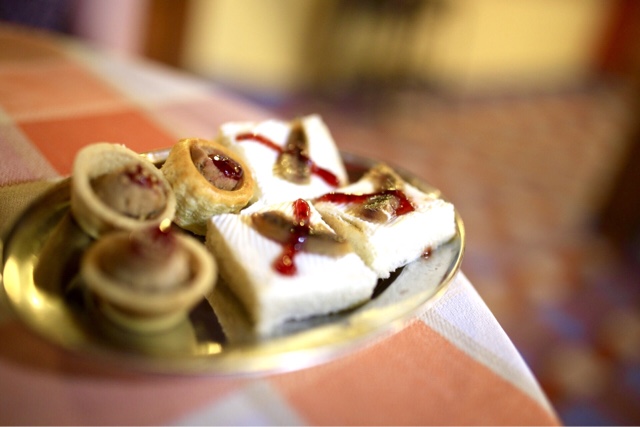by: Mr Robot
 |
| Christmas in a bowl |
I don't know about you, but get l sick of quick & simple easy-peasy ideas for using up leftovers, usually around late October. But don't worry - this isn't one of those. Ramen isn't quick and, if not necessarily difficult, you should be careful. Or at least, full of care.
The first and hardest part for this is, don't eat all the goose. Obvious but trust me it's easier said than done. With incredible willpower we also managed to reserve a couple of pigs in blankets. I know. After depriving Mrs Robot so dreadfully, I really had to make this work.
Goose Broth
The well-scavenged carcass goes in a massive pot with some stock veg, along with a tub of homemade chicken stock and a guinea-fowl carcass I happened to have kicking around. You may consider those optional.
A small handful of peppercorns, a bayleaf and the half-orange I'd shoved up Goosey for roasting also went in, along with about 6-8 pints of water, and it all boiled hard for around 6 hours, scum-skimmed occasionally. Then it was strained and left to cool overnight.
Normally you'd never remove fat from a ramen broth but goose fat is so very oleaginous I didn't want to risk the final broth being overly greasy. So I removed about half the fat and kept it back in case I needed to restore some later. As it turned out I didn't, so that's gone in the fridge for future roasties.
From there I reduced it to about 3 pints in volume, which was the point it hit the richness and intensity I was looking for. I've learned to beware over-reducing so it's always a matter of tasting and judgment now, rather than target volume.
Once reduced I seasoned with a sachet of dashi powder, about 1/2 teaspoon of white pepper, a good couple of teaspoons of salt and, because it felt it needed something, a splash of mirin. I considered a dollop of miso too but in the end opted against - I know I have a tendency to overdo it, so held back. But it was a close thing.
Goose & Pigs
The reserved breast meat and pigs in blankets were sliced about 5mm thick. Half went into the broth for 10 minutes before serving to warm through, the other half fried in a little goose fat. I did that in the hopes of textural interest but frankly we couldn't tell the difference, so that's just washing up for nothing. Some spare goose skin crisped up in the pan and sprinkled on at the end worked a treat though.
Red cabbage
Because a ramen needs some cabbage and Christmas demands it be red. I'd considered pickling but then had a better idea (see below) so simply shredded and braised it gently.
Pickled Sprouts
Oh yeah. Sprouts separated into individual leaves which then sat in a mix of rice wine vinegar, mirin and salt for about 30 minutes brought a very welcome freshness and acidity to what is, after all, an absurdly rich bowl. Honestly I was surprised how well these worked.
 |
| Sprout Genius |
The Egg
Now, we had a bit of an argument about the egg. My idea, nay my vision, was to take festivity to a new level with a Mulled Egg - steeped in red wine vinegar, cinnamon, cloves etc overnight - but Mrs Robot put her foot down like a steam hammer.
In the end we went with salted duck egg which was great but not, you know, my vision.
So that was all assembled over noodles and scattered with a few sesame seeds.
Things I thought of adding but didn't
I'd have loved to incorporate spuds but really couldn't think how to make it work so in the end had to leave them out. Parsnips, on the other hand, could make a great garnish as tiny crispy shavings.
Cranberry seemed an obvious candidate for garnish but Mrs R gets cross about it. I briefly considered a dollop of apple sauce too but since we hadn't had it with the Xmas dinner it didn't feel right.
I wish I'd done more sprouts because they were delicious and they went all too quickly. But if you've never tried it, separating sprout leaves is what's officially known as A Right Pain In The Arse. It could've done with more acidity though, so some fresh apple matchsticks might have made a nice alternative, or possibly a shaving of orange zest at the last minute. To be really swank, a few chunks of blowtorched orange segments would be cool.
My guide in all things ramen is Tim Anderson's Nanban and I thought long and hard about adapting his spicy miso butter to a spicy miso goose fat but ultimately felt I was already skirting the Fatty Event Horizon and as it turned out, I think that was the right choice.
The end result was everything I'd hoped: a lovely bowl of ramen feels perfect for those chilly, grey in-between days. It's deep and intense, but gentle and comforting. Bringing the Christmas flavours in felt very satisfying and, of course, was kind of fun. In fact I'm already plotting next year's Baked Ham Ramen.
 |
| Merry Christmas peoples |
All images (c) PP Gettins


















































